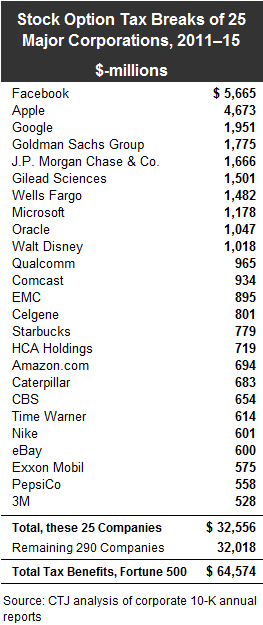June 9, 2016 09:00 AM | Permalink | ![]()
 Apple & Facebook Biggest Beneficiaries
Apple & Facebook Biggest Beneficiaries
One of the most egregious loopholes in the tax code, known as the stock option loophole, allows companies to deduct millions or billions from their taxable income for compensating executives in the form of stock options. Corporations can take these deductions even though granting stock options costs them nothing. CTJ has reviewed five years of corporate filings and found this loophole has allowed companies to annually avoid an average $13 billion in taxes. It should be noted that the average sum corporations are avoiding could be understated because not all corporations report information about stock options.
This report sheds light on how corporations are able to provide sizable compensation to their CEOs and other executives and concurrently use tax code loopholes to reduce their tax bill. It presents data for 315 Fortune 500 corporations that disclose a portion of the tax benefits they receive from this tax break.
HIGHLIGHTS:
# 315 corporations reduced their federal and state corporate income taxes by a combined total of $64.6 billion over the last five years by using the excess stock option tax break.
# In 2015, the tax break cut Fortune 500 income taxes by $14.8 billion.
# Just 25 companies received half of the total excess stock option tax benefits accruing to Fortune 500 corporations over the past five years.
# Facebook and Apple received about 9 percent and 7 percent of the total excess stock option tax benefits during this period, enjoying $5.7 and $4.7 billion in stock option tax breaks respectively over the past five years. Financial giants, JP Morgan, Goldman Sachs and Wells Fargo collectively received about 8 percent of the total.
# Over the past five years, Facebook slashed its federal and state income taxes by 70 percent using this single tax break.
How It Works: Companies Deduct Costs They Don’t Incur
Most big corporations give their executives (and sometimes other employees) options to buy the company’s stock at a favorable price in the future. When employees exercise these options, corporations can take a tax deduction for the difference between what the employees pay for the stock and what it’s worth (employees report this difference as taxable wages).
Before 2006, companies could deduct the “cost” of the stock options on their tax returns, reducing their taxable profits as reported to the IRS, but didn’t have to reduce the profits they reported to their shareholders in the same way, creating a big gap between “book” and “tax” income. Some observers, including CTJ, argued that the most sensible way to resolve this would be to deny companies any tax deduction for an alleged cost that doesn’t require a cash outlay, and to require the same treatment for shareholder reporting purposes.
But instead, rules in place since 2006 maintained the tax write-off, but now require companies to lower their “book” profits to take account of options. But the book write-offs are usually much less than what the companies take as tax deductions. This is because the oddly-designed rules require the value of the stock options for book purposes to be calculated — or guessed at — when the options are issued, while the tax deductions reflect the actual value when the options are exercised. Because companies typically low-ball the estimated values, they usually end up with much bigger tax write-offs than the amounts they deduct as a “cost” in computing the profits they report to shareholders.
Reforming the Excess Stock Option Tax Break
Despite the changes that took effect in 2006, the stock option tax break continues to reduce the effectiveness of the corporate income tax. A February 2014 CTJ report assessing taxes paid by Fortune 500 corporations consistently profitable from 2008 through 2012 identified the excess stock option tax break as a major reason for the low effective tax rates paid by many of the nation’s biggest companies.[i]
In recent years, some members of Congress have taken aim at this tax break. For example, former Michigan Senator Carl Levin (D-MI) introduced the “Cut Unjustified Loopholes Act,” which includes a provision requiring companies to treat stock options the same for both book and tax purposes, as well as making stock option compensation subject to the $1 million cap on corporate tax deductions for top executives’ pay. The stock option loophole essentially allows profitable corporations to underwrite executive compensation on average taxpayers’ dime. Executives are able to cash out when their stock becomes more valuable, and corporations are able to deduct an imaginary cost.
During a time when the nation is failing to raise enough revenue to adequately fund its priorities, lawmakers should move to close the stock option loophole to make the tax system fairer and raise much-needed revenue.
The appendix includes the full list of 315 corporations and the size of their reported federal and state tax break for excess stock options in the five-year period between 2011 and 2015.
[i] Citizens for Tax Justice, The Sorry State of Corporate Taxes, February 25, 2014. http://ctj.org/corporatetaxdodgers/



